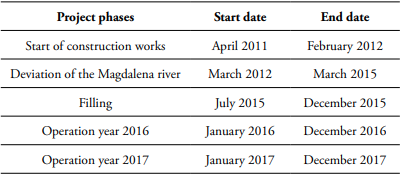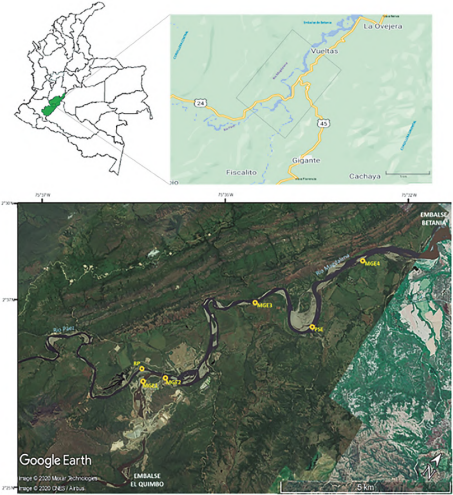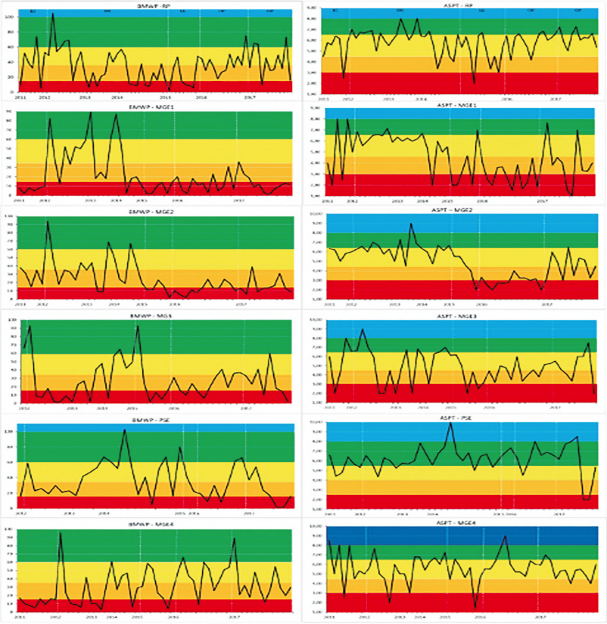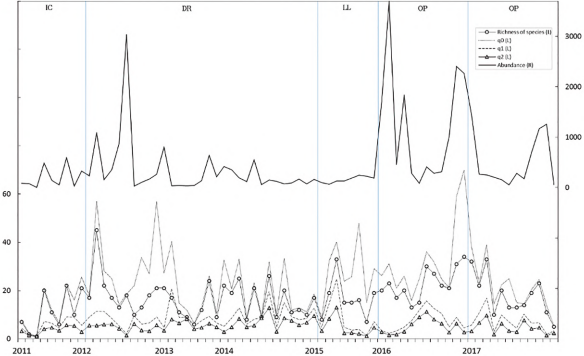Introduction
The Quimbo hydroelectric station has a reservoir of 8, 250 hectares in the Magdalena river. It has an installed capacity of 400 MW, with an average generation of 2,216 GW-h/year, which corresponds to 4% of the national energy demand (ANLA, 2021). It is located in the south part of the department of Huila in the jurisdiction of the municipalities of Gigante, El Agrado, Garzón, Paicol, Tesalia and Altamira. Its construction began in 2010 and its operation in November 2015. Due to its proximity to the Betania hydroelectric plant, almost 30 km, The Quimbo optimizes the cost/benefit because the Betania-El Quimbo complex supplies 8% of the national demand (INGETEC, 2008).
According to the characteristics of different aquatic systems, it is possible to find a series of organisms grouped in communities, which play important roles into trophic nets like producers, consumers of first, second or third order, and in decomposition processes. Most macroinvertebrates are found in these last two groups (Hutchinson, 1957; Needham & Needham, 1978; Roldán & Ramírez, 2008). Macroinvertebrates are relatively big animals, between 0.5 mm or visible to the human eye, up to more than 3 mm (Alba-Tercedor, 1996). This community is represented by oligochaetes, hirudineans, mollusks, and particularly arthropods, like crustaceans, arachnids and, the most abundant, insects (Barajas et al., 2004; Roldán & Ramírez, 2008; Valbuena-Villareal & Gualtero-Leal, 2021). In general, macroinvertebrates are associated with rocky or muddy bottoms of water sources, in aquatic plants, edge of water sources, near or on the surface of water (Merritt & Cummins, 1996; Pratt, 1992; Ramírez & Viña, 1998).
Environmental as well as flow and physicochemical variations can change the composition of the communities at a given moment of the sampling due to alterations in the biological limits and modifications of the supply of resources, which allows them to be used as an indicator group of environmental quality (Madera et al., 2016). Most macroinvertebrates meet the requirements of a bioindicator: abundant, easy to collect and handle, stable taxonomy and a relatively well-known biology, among others (Bonada et al., 2006; Jacobsen, 2008a, 2008b; Prat et al., 2008; Villalobos-Moreno, 2017; Villalobos-Moreno & Salazar, 2020).
This study aimed to analyze of the hydrobiological communities of the flows from the El Quimbo hydroelectric dam to the beginning of the Betania dam reservoir (Huila, Colombia) in order to establish possible changes in the macroinvertebrate communities. A sampling time method was adopted among the different monitoring stations, from April-2011 to December-2017, the date range between the construction and the second year of operation of the hydroelectric station. Table 1 shows that the project phases were limited.
Materials and Methods
Study área
The Quimbo reservoir is located in the south part of the department of Huila, in the upper basin of the Magdalena river, between the Central and Eastern mountain ranges (Fig. 1). This part of the river runs from the Colombian Massif to 1,300 m before the confluence of the Magdalena and the Paez rivers, between the geographical coordinates 1°30’N - 76°35’W and 2°30’N - 75°35’W, jurisdiction of the municipalities of Garzón, Gigante, El Agrado, Paicol, Tesalia and Altamira. The reservoir has an approximate longitude of 55 km, a maximum height of 720 masl, and an average width of 1.4 km, which corresponds to a flood area of 8,250 hectares and a total volume of 3.205 hm3 (ANLA, 2021). For the sampling, six stations located from the dam of the Quimbo reservoir, to the beginning of the end of the Betania reservoir were established.
Station I (RP): Lotic system located on the Páez river near the point of confluence with the Magdalena river (2°27’25.66”N; 75°34’22.87”W), area of jurisdiction of the Gigante municipality, Huila. It features a medium slope with some erosion, as well as arboreal and shrubby vegetation on both banks. The riverbed is rocky with sandy and rocky beaches nearby. The water appearance is cloudy, yellowish, without offensive smells, no iridescence or floating material. On average, at this site the river is 70 m wide and 2 m deep.
Station II (MGE1): Lotic system waters under the Quimbo reservoir, located in the Magdalena river waters underneath the reservoir discharge (2°27’25.56”N; 75°34’11.69”W; 595 masl), area of jurisdiction of the Gigante municipality, Huila. It features a medium slope with some erosion, arboreal and herbaceous vegetation on both banks; rocky bed, sandy substrate with sandy and rocky beaches nearby. The appearance of the water is cloudy, brown, without offensive odors or iridescence, with a moderate presence of leaf litter and particulate matter. On average, in this place the river is 48 m wide and 1.7 m deep.
Station III (MGE2): Lotic system waters under the Quimbo reservoir, located on the Magdalena river near the point of confluence with the Paez river (2°27’46.43”N; 75°34’2.07”W; 589 masl), area of jurisdiction of the Gigante municipality, Huila. It features a low slope, the right bank has little vegetation and the left bank has some arboreal and shrubby vegetation. Rocky bed, sandy substrate with sandy and rocky beaches nearby. The appearance of the water is semi-cloudy, brown, without offensive odors or iridescence, with a moderate presence of leaf litter and particulate matter. At this site the river is 150 m wide and 2.5 m deep.
Station IV (MGE3): Lotic system waters at confluence of the Paez and Magdalena rivers (2°29’40.54”N; 75°33’29.84”W; 576 masl), area of jurisdiction of the Gigante municipality, Huila. It features a low slope, the right bank has herbaceous, arboreal and shrubby vegetation, as well as rocky beaches, the road to the municipality of Gigante and some cattle farms, while on the left bank the area is mountainous with rocky slopes. The river bed is sandy and the substrate is rocky. The appearance of the water is semi-cloudy, brown, without offensive odors and with the moderate presence of surface white foam. On average, this point of the river is 88 m wide and 2.5 m.
Station V (RM-PSE): Lotic system located in the Magdalena river waters underneath the Quimbo reservoir, in the Puerto Seco farmhouse (2°30’5.44”N; 75°32’35.12”W; 574 masl), area of the jurisdiction of the Gigante municipality, Huila. It features a low slope, on both banks arboreal and shrubby vegetation can be seen, rocky beach and livestock, agricultural and industrial activities. The river bed is rocky-sandy. The appearance of the water is semi-cloudy, brown, without offensive odors or floating matter. On average, at this point the river is 180 m wide and 2 m deep.
Station VI (MGE4): Lotic system waters underneath the Quimbo reservoir, relatively near to the Betania reservoir (2°31’37.60”N; 75°32’15.80”W; 564 masl), area of the jurisdiction of the Gigante municipality, Huila. It features a low slope, on both banks there is arboreous and shrubby vegetation, rocky beach on the right and a mountainous area on the left, as well as certain agricultural and livestock activities. The riverbed is sandy and the substrate is rocky. The appearance of the water is semicloudy, brown, without offensive smells or iridescence, or floating matter. At this point, the river is 200 m wide and 2 m deep.
Sampling methods
In each of the stations, aquatic macroinvertebrates were sampled every week, between April 2011 (start of the construction) and December 2017 (second year of operation of the hydroelectric plant). The biological material was collected using a Surber net of 30 cm x 30 cm and 560µm mesh eye, located against the flow of water and considering the presence of different environments: torrent, basin and threshold. At each station, along a 100 m longitudinal transect, 10 sites were delimited, and the sampling was done with the Surber net for 5 minutes. The collected specimens were preserved in ethanol 70% (Barajas et al., 2004; Pinheiro et al., 2004; Roldán & Ramírez, 2008). The identification was done in the laboratory with keys and descriptions of Domínguez et al. (2006), Domínguez & Fernández (2009), Posada-García & Roldán-Pérez (2003), Roldán-Pérez (1988) and Springer (2006).
Spatio-temporal chances of communities
To establish possible changes in the aquatic macroinvertebrates communities, both in time and in each of the sampled stations, the BMWP and ASPT indices were calculated for each of the project phases. Further, these same analyses were performed with the biodiversity parameters: abundance, richness of species observed and numbers of Hill.
To calculate the BMWP index (Biological Monitoring Working Party) the method adapted by Roldán-Pérez (2003) for Colombia (BMWP/Col) was used. This method uses macroinvertebrates as bioindicators in terms of presence-absence and assigns them a score from 1 to 10; this score has been previously established according to ecological sensibility (Roldán-Pérez, 2003, 2016), and assigns a quality level and a color (Table 2). Since the BMWP index depends on the sampling effort, the ASPT index (Average Score per Taxon) was also calculated by dividing the BMWP by the number of collected taxa. In this way, the ASTP index translates the average of the lowest limit of sensibility to contamination by the taxa of a group, at a value of environmental contamination, which is not dependent on the sampling effort (Cammaerts et al., 2008).
The Hill numbers were established using the values of abundance and richness of species observed for each sampling stations and each of the phases of the hydroelectric project: q0 = potential richness, q1 = diversity of order 1 (exponential of Shannon-Wiener: eH’) and q2 = diversity of order 2 (inverse of Simpson: 1/D) (Moreno et al., 2011; Núñez & Barro, 2003; Villalobos-Moreno et al., 2016). To calculate the series of numbers of Hill, the SpadeR program (Chao et al., 2016), which shows these numbers and the standard deviation, was used. The unit of the numbers of Hill is the number of species. The numbers of Hill measure the effective number of species present and they are a measure of the degree of distribution of relative abundances among species in a sample; so, q0 correspond to total number of species, q1 is the number of abundant species, and q2 is the number of very abundant species ( q0 > q1 > q2 ) (Jost, 2010). The diversity parameters were analyzed by performing a Bonferroni test in order to establish correlations among them. For this analysis, the means and standard deviations were previously calculated; in both cases, the Statistica 8.0 program was used (StatSoft, 2007).
Table 2 Classification of waters and ecological meaning, according BMWP and ASPT.
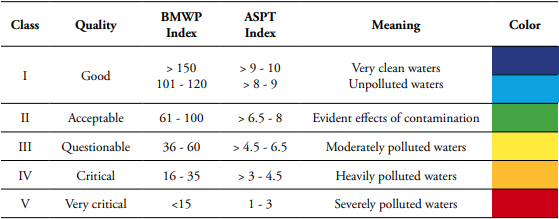
Source: Cammaerts et al., 2008 & Roldán, 2003.
Results and discussion
A total of 36,490 individuals of the aquatic macroinvertebrate community were analyzed. They were organized into 11 classes, 26 orders, 79 families and 168 taxa (Fig. 3, Table 3). The class Insecta was the best represented in the samplings, in terms of abundance and taxonomic groups. This class presented nine orders (34.62%), 55 families (69.62%) and 137 taxa (81.55%). The best represented orders in the sampling area were Diptera with 21,172 specimens (33.35%), 13 families and 31 taxa, Ephemeroptera with 5,769 specimens (15.81%), 20 families and 20 taxa, Hemiptera with 4,196 specimens (11.5%), 9 families and 17 taxa, and Trichoptera with 2,267 specimens (6.21%), 7 families and 20 taxa. These four orders represent about 67% of all the biological material collected, 62.03% of the total families and 52.38% of the taxa recorded for the study area (Valbuena-Villareal & Gualtero-Leal, 2021).
Spatio-temporal chances of communities
About the calculated indexes: the BMWP/Col and the ASTP showed obvious fluctuations in each of the sampling stations and throughout the established years from the dam construction to the second year of operation of the hydroelectric project. An engineering work of this magnitude would be expected to affect the natural variations of macroinvertebrates due to droughts and floods, but the fluctuations are still observed throughout the year during all the phases sampled, possibly due to the contribution of the abundant flow of the Paez river. However, significant and constant decreases of BMWP/ Col index were observed in the sampling stations MGE1, MGE2, MGE3 and PSE, from the end of the river deviation phase (DR) to end of second year of operation (OP). This same decrease, although not as constant, is observed for the ASPT index during the filling phase (LL) and the first year of operation (OP) in the sampling station MGE1, MGE2 and MGE3 (Fig. 2). Possibly, this behavior of the indexes is explained by the variation of the diversity of the macroinvertebrates in the stations closest to construction, and that these biological parameters remain relatively stable at the most distant sampling stations (PSE y MGE4), as well as in the RP station located at the confluence with the Paez river (RP). Likewise, the relatively high values of the indexes during the critical project stages, such as deviation of the river (DR) and reservoir filling (LL) can be explained by the large volume and good quality of the water provided by the Paez river.
About the diversity parameters established: the abundance, density, and richness of species and numbers of Hill showed fluctuations from the dam construction date to the second year of operation of the hydroelectric project. The increase in abundance was very evident, in mid 2013, throughout the river deviation and the years of operation sampled (Fig. 3). Regarding the richness of species, very evident increases in the number of species at the beginning of the years 2012, 2015 and 2017 were observed, possibly synchronized with the start of the rainy seasons. The highest values of calculated potential richness (q0) were obtained at the beginning and the end of 2012, and mid 2015 and end of 2016, possibly related to the second rainy season. However, these analyses must be carried out in greater detail because the results may be different depending on the study locations; e.g. Ramírez et al. (2013) report an increase of abundance with increased rainfall, but Forero & Reinoso (2013) established the opposite, and they explained it by the greater drag of macroinvertebrates when water currents increase.
The analysis of correlation using a test of Bonferroni (Table 3), allows to observe that the abundance was only related with the richness of species observed (R= 0.646; p < 0.001), while the richness of species observed was related with the potential richness of species (R= 0.848; p < 0.001) and with the effective richness of species (R= 0.445; p < 0.001). Likewise, between the true diversity variables (Numbers of Hill) was only observed a correlation between the effective richness of species and the richness of dominant species (R= 0.947; p < 0.001); therefore, as effective richness increases, the number of dominant species increases as well. This greater or lesser correlation between the variables may be conditioned to various temporal changes throughout the year. For example, at the beginning of almost every year, the abundance and potential richness (q0) increase considerably, although this increase is not clearly reflected on the other variables of true diversity (q1 y q2), possibly due the presence of some species with low number of specimens. It is important to expand these analyses with environmental factors that allow the fluctuations in the diversity parameters used to explain, in more detail, something that will be done in future manuscript.
Table 3 Results of analysis of correlation between parameters of diversity. Ab: Abundance; R.Ob: Richness observed of species; q0: Diversity of order 0; q1: Diversity of order 1; q2: Diversity of order 2.
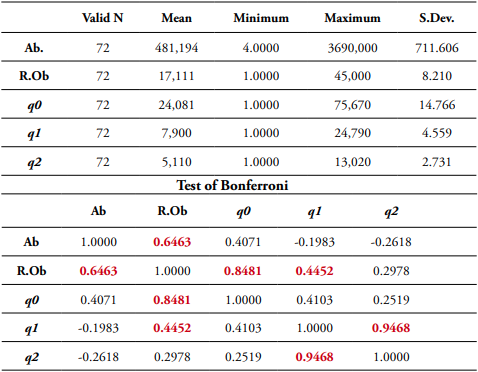
Source: Rubén Darío Valbuena-Villareal.
Conclusions
The indexes and the calculated biodiversity parameters throughout the sampling years show expected variations due to natural flow fluctuations, rainfalls and physiochemical factors. A reduction in the BMWP/Col and ASTP indexes were observed in some phases of this hydroelectric project, although only for the stations closest to the dam. In this way, and as expected, along the river route, communities are re-established in a natural way. The evident increase in abundance and richness of species at the end of the filling phase (LL) and during the two years of operation (OP) is highlighted.













